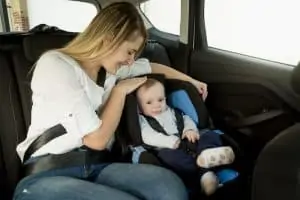In China, I was terrified of being in a car while pregnant. This was largely because I’d have to take taxis all around, and in the backseats of 99.9% of those taxis, the seat belts weren’t there.
Thus, I’d cling to the upholstery and pray.
But here in the states, we have particular laws and requirements about seat belts. So you can breathe a sigh of relief. Sort of.
Some mamas have been asking me if there is a seat belt for pregnant women, especially on the bumpy road. A maternity seat belt of sorts, and while I have seen things on the market, I’m going to give you the lowdown on those.
- Seat belts will always save lives though pregnant women need to wear them properly.
- Find out the right way to secure your seat belt as you move through your trimesters.
- See what the experts say about using a pregnancy seat belt protector.
First, let me answer all those burning questions about seat belt safety during pregnancy!
Do seat belts harm fetuses?
According to the Virginia Department of Health, this is a terrible myth that women must stop believing immediately. It is dangerous not to wear your seat belt for anyone.
And pregnant women are three times more likely to lose their baby in a car accident if they do not wear one. You will also be more likely to have excessive maternal bleeding.
And I want to emphasize something here: YES, EVEN IN A MINOR ACCIDENT!
The Virginia Department of Health cited a study from 2008 that came out of the University of Michigan. In that study, it was estimated that the proper use of seat belts by pregnant women would save about 200 fetuses every year.
Additionally, car crashes without seat belts in use can cause fetal distress, premature births, abnormal conditions, and a slew of horrid complications for your baby.
And for you, you have a greater chance of complications through fractures, internal injuries, and blood clots. Since your uterus and bladder are not as protected by your pelvis once you go beyond 12 weeks of gestation, these body parts can become injured more easily too.
So, in short, please wear your seat belt.
Is it compulsory to wear a seat belt during pregnancy?
Yes, you must wear a seat belt in the U.S. Buckling up is the law here; depending on your state, you could also be fined.
That would be the least of your worries, I’d think.

Doctors recommend that if you are pregnant, wear your seat belt and keep your airbags on. This will give you the best protection in the event of an accident. The National Highway Traffic Safety Administration (NHTSA) has this incredible infographic you can look at, too, if you need a visual of how you should wear your seat belt.
If you don’t use a seat belt, you could bounce around the vehicle’s interior and smack into anyone else in the car. You could also be ejected from the vehicle.
A girl I knew in one of my college classes years ago was not wearing a seatbelt. She was driving to meet friends at a local hangout and never made it. There was a big football game, and our team won, so everyone celebrated. One guy got behind the wheel and drove drunk.
According to the police, she probably didn’t even know that it had been instantaneous. It was such a sad situation, only made even sadder by the fact that she could have lived through it if she’d been wearing her seat belt.
After the autopsy, it was found that she was also pregnant and in the early stages. Her boyfriend, whom she’d been with for 2 years, was inconsolable after finding out because he’d been planning to propose.
It’s such a sad story that still haunts me to this day. Please, mamas, wear your seat belts.
Are lap belts safe during pregnancy?
Yes, the lap belt is safe during pregnancy too. But you must put it under your belly. The proper way is to wear it low, so it is snug on your hip bones, never across your belly or above your belly.
If you wear the lap belt properly while pregnant, it will protect you and your baby in the event of an accident.
You need to wear your shoulder belt too. It should fit right between your breasts yet be off to the side of your belly. If it cuts across your neck (and this goes for when you are not pregnant, too), move your seat or adjust the belt until it is in the correct position.
NEVER put the shoulder belt behind your back or underneath your arm.
Also, take off your coat before you buckle up if it’s winter. If you’re cold, drape it over yourself like a blanket until the heater warms the interior. Heavy clothes make it hard for your seat belt to fit securely around you.
PSA: When you have your baby, always take them out of their winter jackets before buckling them into their car seats. This is why you must remove your coat before buckling up.
Risks of not wearing seat belts during pregnancy
I think I just mentioned how risky it is not to wear a seat belt during pregnancy. You’ll go right into the airbags without a seat belt to restrain you. The airbags are meant to work in conjunction with your seat belt.
Please buckle up. I always think about that girl from college which has been over 20 years. You could be severely injured from bouncing around inside the vehicle. You can hurt your other passengers. And you can be thrown from that vehicle through the windshield or other windows onto the pavement.
Do you need a special seat belt when pregnant?
Now, there are some enterprising people out there who think they have created a pregnancy seat belt protector. The problem here is that there is no official NHTSA-approved seat belt adjuster.
Experts warn against using these things because there are no safety standards for any of them. The NHTSA has officially approved none at this time. Repositioning a seat belt or changing how it functions can be deadly.
Some say you can use a seat belt extender, but again, I cannot find a single item approved by the NHTSA, so I urge you not to use one. Your seatbelt should extend plenty on its own, and again, the lap belt portion needs to go underneath your baby belly, not on top of it.
According to an article from Consumer Reports, you should be very concerned about these items marketed to you. The government must set standards or regulate these items and be crash-tested properly.
MimiBelt claims to be approved, but it is not.
In that article, I’d like to pull out a key quote from NHTSA about aftermarket seat belt adjusters, which states, “do not fall under regulations, since they are neither installed as part of a completed vehicle nor as part of a seat belt assembly.”
Tummy Shield is another one that makes claims that it is safe. While it does not claim approval from any government agency, the company does say it withstood impacts in a simulated crash.
I’m sorry, but that’s not enough for me to feel safe. And you shouldn’t either. This is your life and your baby’s life too. The NHTSA has approved many incredible new technologies in our vehicles. I am sure that if they find something that works and has been tested repeatedly with stellar results, it will be on the news everywhere.
Until then, skip these items marketed to you and wear your seat belt properly while pregnant.
How to wear a seat belt during pregnancy for maximum safety?
Again, NHTSA and doctors recommend you wear your seat belt while pregnant. They also recommend you keep your airbags on. You should scoot your seat back a little as your belly grows to accommodate it, about 10 inches away. You should still be able to reach the gas and brake pedals and clutch if you have a manual transmission.
Your shoulder belt should cross right over your collarbone and be positioned between your breasts without hitting your neck. The shoulder belt should never be put behind your back or under your arm. That lap belt on its own could do more harm if you wore the seat belt in the wrong way.
Your lap belt portion of your three-point safety belt should fit snuggly underneath your baby bump and go across your hips.
If you are not driving and are riding as a passenger, it is safest for you to sit in the back seat in most cases. The only exception is if the seat belts in the back are only lap belts.
I hope this post has been helpful to you in knowing how to protect yourself while driving or riding in vehicles. It only takes seconds for an accident to happen, but when you wear your seat belt correctly during your pregnancy, you and your baby will get through it with better results.
Leslie Berry lives with her husband and two young daughters in Los Altos, California, where she loves helping other moms get comfortable with motherhood and embracing the insanity with facts peppered with laughs.
She loves eating too much sushi, exercising, and jamming out on her Fender. Read more about Leslie here.






